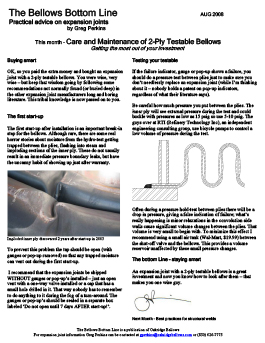Maintaining 2-ply Testable Bellows On Expansion Joint

Buying smart
OK, so you paid the extra money and bought an expansion joint with a 2-ply testable bellows. You were wise, very wise – but keep that wisdom going by following some recommendations not normally found (or buried deep) in the other expansion joint manufacturers long and boring literature. This tribal knowledge is now passed on to you.
The first start-up
The first start-up after installation is an important break-in step for the bellows. Although rare, there are some real horror stories about moisture from the hydro-test getting trapped between the plies, flashing into steam and imploding sections of the inner ply. These do not usually result in an immediate pressure boundary leaks, but have the uncanny habit of showing up just after warranty.Imploded inner ply discovered 2 years after start-up in 2003
To prevent this problem the tap should be open (with gauges or pop-up removed) so that any trapped moisture can vent out during the first start-up.
I recommend that the expansion joints be shipped WITHOUT gauges or pop-up’s installed – just an open vent with a one-way valve installed or a cap that has a small hole drilled in it. That way nobody has to remember to do anything to it during the fog of a turn-around. The gauges or pop-up’s should be sealed in a separate box labeled ‘Do not open until 7 days AFTER start-up!’.
Testing your testable
If the failure indicator, gauge or pop-up shows a failure, you should do a pressure test between plies just to make sure you don’t needlessly replace an expansion joint (while I’m thinking about it – nobody holds a patent on pop-up indicators, regardless of what their literature says).
Be careful how much pressure you put between the plies. The inner ply will see external pressure during the test and could buckle with pressures as low as 15 psig so use 5-10 psig. The guys over at RTI (Refinery Technology Inc), an independent engineering consulting group, use bicycle pumps to control a low volume of pressure during the test.
Often during a pressure hold-test between plies there will be a drop in pressure, giving a false indication of failure; what’s really happening is minor relaxations in the convolution side walls cause significant volume changes between the plies. That volume is very small to begin with. To minimize this effect I recommend using a small air tank (Wal-Mart, $19.99) between the shut-off valve and the bellows. This provides a volume reservoir unaffected by these small pressure changes.
The bottom Line – staying smart
An expansion joint with a 2-ply testable bellows is a great investment and now you know how to look after them – that makes you one wise guy.


